Are you considering whether Amazon Individual vs Professional is right for you? Individual accounts are ideal for low-volume sellers (pay per item) with less control. In contrast, professional accounts pay monthly fees but offer more features and are ideal for higher sales potential.
In short, that’s it, but what are the detailed differences between these types of Amazon seller accounts This article will delve into those different aspects, including:
- Cost to Use
- Features (Listing, inventory, marketing, and reporting)
- Restrictions
Let’s dig into it now!
Amazon Individual vs Professional – Account Overview
What is Amazon Individual seller account?
An Amazon Individual Seller account operates on a pay-as-you-go basis. You are charged a per-item fee of $0.99 for each item sold. And, there is no monthly subscription fee you need to pay.
This account type is ideal for casual sellers (those who sell less than 40 items per month) or those just starting out who want to test the waters before committing to a more comprehensive selling plan.
What is Amazon Professional seller account?
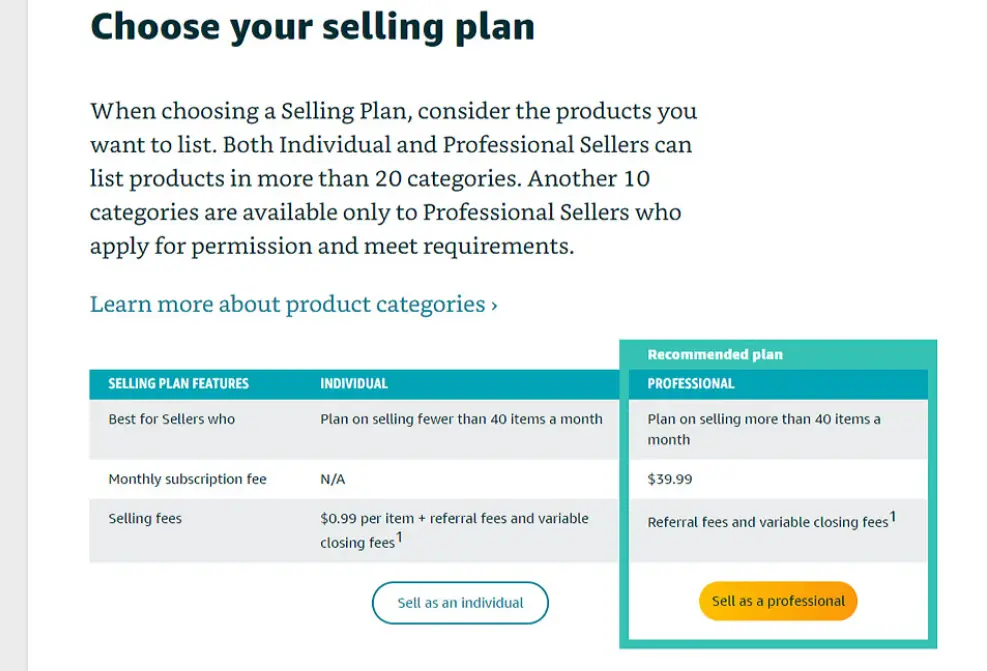
In contrast, an Amazon Professional Seller account is designed for businesses and serious sellers planning to sell a higher volume of products on Amazon (more than 40 items per month). With this account, you pay a monthly subscription fee of $39.99, regardless of the number of items you sell. However, you won’t incur the per-item fee that applies to the Individual plan.
Similarities between Individual vs Professional Amazon seller accounts
Despite the differences, both account types share some commonalities, particularly in the additional fees beyond the basic fee structures:
- Referral fees: Both Amazon Professional and Individual accounts incur referral fees, which are a percentage of the item’s total price, including shipping and any gift-wrapping charges. These fees vary by category and can range from 6% to 45%, with an average of around 15%.
- Closing fees: For media items (such as books, DVDs, etc.), there is a fixed closing fee of $1.80 per item, applicable to both Amazon Professional vs Individual accounts.
How Amazon Individual Compares to Professional Plan?
Between Amazon individual vs professional accounts, each caters to a different level of selling volume and offers distinct features and limitations. Here’s a detailed breakdown of the key differences between these two types of Amazon seller accounts:
Feature | Amazon Individual Seller Plan | Amazon Professional Seller Plan |
Cost | Per-item fee: $0.99 per item sold | Monthly subscription fee: $39.99 (regardless of sales) |
Additional Fees | Referral fees, Closing fees | Referral fees, Closing fees, High-volume listing fees (for over 100,000 listings), FBA fees (storage & fulfillment) |
Listing & Inventory Tools | Manual listing creation, Limited variation management, Manual inventory tracking | Bulk upload feature, Advanced variation management, Inventory Management (AIM) tools |
Advertising & Promotion | Limited options, No access to Sponsored Products | Access to Sponsored Products program (PPC ads), Broader promotional tools (Lightning Deals, Subscribe & Save) |
Reporting & Analytics | Basic sales data, Limited reports & customization | Comprehensive suite of reporting tools, Granular data, Extensive customization options |
Restrictions | Selling limits, Product category restrictions (approval needed), Lower priority seller support | More flexible listing limits, Easier category approval, Priority seller support |
Brand Gating | Harder to get approval | Easier to get approval |
International Selling | Access, limited resources | Access, more resources |
Total cost of selling
As stated above, when using the Individual Seller account, you need to $0.99 per item sold (excluding closing fees, variable closing fees, and fulfillment fees).
Meanwhile, if you choose a Professional Amazon Seller account, you have to charge a monthly subscription fee of $39.99, regardless of the number of items sold.
Regarding additional costs, beyond the fees mentioned in the previous section that apply to both Amazon Individual vs Professional plans (Referral fees, Closing fees), Professional Amazon sellers may incur some other Amazon seller fees, such as:
- High-volume listing fees: For Professional sellers listing over 100,000 items, Amazon charges additional fees to manage the extensive inventory. The exact fees may be negotiated on a case-by-case basis, depending on the specific storage requirements.
- Fulfillment by Amazon (FBA) fees: While individual sellers can technically use Amazon FBA, it’s not a practical choice if you sell more than 40 items per month. Therefore, FBA is typically used by sellers with Professional accounts. Sellers who use FBA must account for storage and fulfillment fees, which are charged based on the product’s size and weight.
Basically, Individual sellers pay per item sold, while professional sellers pay a monthly fee. Potentially, additional fees are incurred for high-volume listings or FBA usage.

Features
The cost structure of each account type is a major differentiating factor between Amazon individual vs professional selling plan.
Listing and inventory tools
Regarding the creation of listings, the process differs between the Amazon Individual vs Professional accounts:
- With the Amazon individual selling plan:
- Manual listing: You need to create listings one by one, manually entering all product details, including title, description, images, and basic variations (e.g., size and color). This can be time-consuming if you have many products.
- Limited variations: You can only manage basic product variations, making it difficult to handle complex combinations of attributes like size, color, and material.
- With an Amazon professional seller account:
- Bulk upload: You can upload product information in bulk using spreadsheets or APIs. This saves a lot of time and effort, especially if you have a large inventory.
- Advanced variations: You can easily manage complex product variations with multiple attributes (e.g., size, color, material), ensuring accurate product representation.
Moving on to inventory management:
- The Amazon seller individual plan requires you to manually track inventory levels or use simple spreadsheets. Unfortunately, this manual approach can be error-prone and inefficient, especially when managing a large number of products. Additionally, this plan limits your ability to forecast inventory needs, potentially leading to stockouts or overstocking, which can negatively impact your business.
- In contrast, the Professional Amazon seller plans are equipped with Amazon Inventory Management (AIM) tools. These tools provide access to advanced inventory management sub-tools, which offer better control and optimization. For example:
- The Inventory Replenishment Tools automate inventory restocking based on sales data and lead times, minimizing the risk of stockouts.
- The Inventory Performance Index (IPI) tracks your inventory management efficiency and helps you avoid storage fee increases.
In short, individual plans involve manual listing creation and limited variation management, while professional plans enable bulk uploads and advanced variation handling. Inventory management is manual for individual plans, whereas professional plans provide sophisticated tools like automated restocking and performance tracking.

Advertising and promotional tools
There is a distinct disparity in the advertising and promotional resources provided for Amazon Individual vs Professional accounts.
Individual Amazon selling plans have very limited options for promoting their products. Sellers in these plans primarily rely on organic search ranking within Amazon’s search results and basic marketing efforts outside of the platform. However, one major drawback is that sellers in individual plans do not have permission to use the Sponsored Products program.
Note: Sponsored Products is Amazon’s pay-per-click (PPC) advertising program that allows sellers to create targeted ads for their products. These ads appear in prominent placements on Amazon search results pages (SERPs) and product detail pages, significantly increasing product visibility and driving sales.
On the other hand, upgrading to a Professional Seller Account unlocks a series of powerful marketing tools.
- With a professional account, you gain access to the Sponsored Products program, allowing you to leverage features such as:
- Campaign targeting: Target specific keywords relevant to your products to ensure your ads are shown to shoppers actively looking for similar items.
- Bidding strategies: Set your budget and bidding strategy to control how much you pay for each click on your ad.
- Campaign performance tracking: Track the performance of your campaigns, including impressions, clicks, and conversions. As a result, you can optimize your strategies for maximum return on investment (ROI).
- Professional sellers may also have access to other promotional tools offered by Amazon from time to time, such as Lightning Deals or Subscribe & Save offers.
To sum up, Individual plans have limited promotional options and no access to Sponsored Products, a significant pay-per-click advertising program. Professional plans unlock Sponsored Products and potentially other promotional opportunities, significantly enhancing product visibility and sales potential.
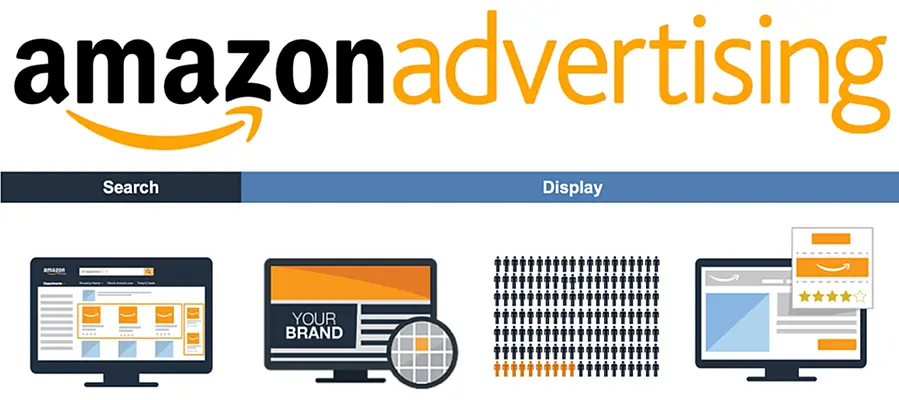
Reporting and analytics capabilities
It is not surprising that there is a noticeable difference in the reporting and analytics capabilities of Amazon individual vs professional accounts.
Individual seller accounts offer limited reports, primarily focusing on basic sales data. You can access information such as total sales, number of items sold, order details (order ID, customer name, order date), and basic traffic sources like referred traffic and browse traffic. However, the data provided is not very granular, meaning you can’t delve deeper into specific metrics or analyze trends over time. Furthermore, individual Amazon selling plans offer little to no customization options for reports, leaving you with the basic information provided by Amazon.
On the other hand, a Professional seller account provides access to a comprehensive suite of reporting and analytics tools. These tools offer detailed insights into various aspects of your business, including:
- Sales performance: Track sales by product, category, brand, and time period. Analyze trends and identify top-selling products.
- Traffic sources: Learn where your traffic comes from (e.g., search keywords, product browsing, referral sources).
- Customer behavior: Analyze customer demographics, purchase history, and behavior patterns.
- Conversion rates: Track conversion rates at different stages of the sales funnel and identify areas for improvement.
- Inventory performance: Monitor inventory levels, analyze sales velocity, and identify potential stockouts or overstocking issues.
- Advertising performance: If you use Sponsored Products, track the performance of your advertising campaigns (impressions, clicks, conversions, return on ad spend).
The data provided is highly granular, allowing you to analyze performance at a product, category, or even day-to-day level. Alternatively, a Professional Seller Account offers significant customization options for reports. You can filter data by specific criteria, drill down into specific metrics, and create custom reports tailored to your needs.
In brief, Individual plans offer basic sales reports with limited granularity and no customization. Professional plans provide comprehensive reporting and analytics tools, offering detailed insights into sales, traffic, customer behavior, conversion rates, inventory, and advertising performance, all with extensive customization options.
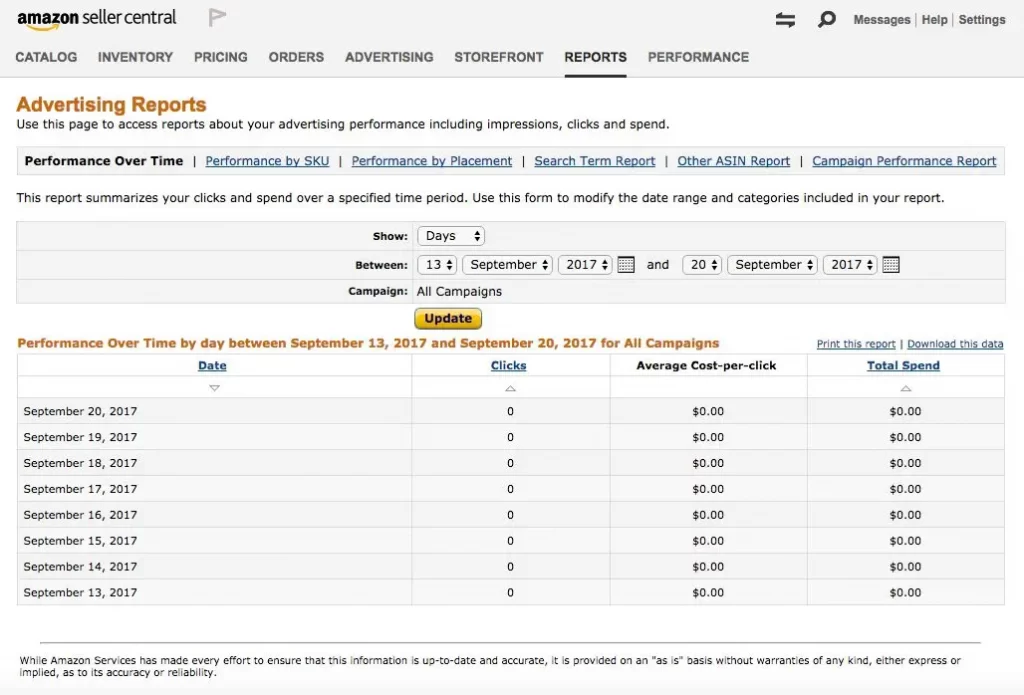
Restrictions
There are distinct and lesser-known restrictions that differentiate between the Amazon seller individual plan vs professional plan, and we are here to reveal them to you.
- Selling limits: With an Amazon individual seller account, you may encounter limitations on the total number of items you can list, especially in restricted categories like electronics or collectibles. You might also face listing limitations or require approval for high-volume listings. Meanwhile, professional seller accounts offer more flexibility in terms of listing quantities and are less likely to face restrictions on the number of items you can sell.
- Product category restrictions: Individual seller accounts may require approval from Amazon to sell certain product categories. Obtaining approval can be more challenging with an individual account, especially for restricted categories that involve higher-value products, safety concerns, or brand exclusivity. Conversely, professional seller accounts generally have an easier time getting approval to sell in restricted categories. Amazon may view professional sellers as more committed and established, making them more trustworthy for handling these types of products.
- Amazon Individual vs Professional – Account health and seller support:
- Your account health (measured by metrics like order fulfillment rate and customer feedback) is still crucial for an individual seller account. However, the consequences of poor account health might not be as severe as for a Professional account.
- Professional seller accounts, on the other hand, have stricter requirements for account health. Poor performance can lead to account suspension or limitations on selling privileges. Professional sellers often receive priority access to Seller Support, which can be helpful for resolving issues and getting assistance quickly. This is vital as professional sellers tend to have more complex operations and may encounter more challenges.
Moreover, there are specific areas where the Amazon seller individual plan imposes more restrictions compared to the Professional plan, including:
- Brand gating: Certain brands on Amazon require approval to sell their products. This approval process can be easier with a Professional seller account.
- International selling: Both account types can sell internationally, but Professional sellers may have access to additional tools and resources for managing international sales.
Which Amazon Selling Plan is Right for You?
As we stated above, each plan caters to different types of sellers based on their needs and business models. To determine which plan is best for you, consider your sales volume, and business goals. This detailed guide will help you make an informed decision between Amazon Individual vs Professional.
Consider your sales volume

When deciding between the Amazon professional seller vs Individual, your expected sales volume plays a crucial role. Let’s explore the options based on different sales volumes:
- Low volume (Under 40 items/month): Ideal for testing the waters or managing a small inventory. The Individual plan offers a low upfront cost with no monthly fees, making it a budget-friendly option.
- Medium volume (40-150 items/month): For medium sales volumes, the decision becomes a bit trickier. The per-item fee of the Individual plan can add up, while the Professional plan’s $39.99 monthly fee might initially seem expensive. It’s important to do the math! If your monthly sales exceed the break-even point, where the monthly fee becomes cheaper than the accumulated per-item fees, then it is more cost-effective to choose the Professional plan. Additionally, the Professional plan offers advanced tools for growth.
For example, if you sell 50 items per month at an average price of $20, your total selling fee on the Individual plan would be $50 ($0.99/item * 50 items). In this scenario, the Professional plan’s monthly fee of $39.99 becomes more cost-effective.
- High volume (Over 150 items/month): The Professional plan is designed for you! High-volume sellers benefit from its cost-efficiency and advanced features. Bulk listing and advertising tools are essential for managing a large inventory and maximizing sales.
Evaluate your business goals

While sales volume is important, your long-term vision for your Amazon business should also guide your choice between the Amazon individual seller vs professional :. Here’s a breakdown based on your goals:
- Short-term experimentation: If you’re in the early stages of selling on Amazon and want to test the waters, the Amazon seller individual plan is a good starting point due to its lower upfront cost. You can list a limited number of products and assess your sales performance before committing to a professional account.
- Long-term growth and scalability: If you have ambitious growth goals and plan to scale your business on Amazon, the Professional seller account is the better choice. Advanced features like bulk listing tools, improved inventory management, and advertising capabilities become essential for managing a growing product catalog. These features also help you optimize listings for better search ranking and reach a wider audience.
- Brand building: If building a strong brand presence on Amazon is a key goal, the Professional seller account offers advantages. You gain access to Amazon Brand Registry, a program that helps protect your trademarks and intellectual property. Additionally, features like enhanced brand content and A+ content creation tools allow you to create a more professional and engaging brand experience for customers, fostering brand loyalty.
- International selling aspirations: If you plan to sell your products internationally on Amazon marketplaces outside your home country, the Professional seller account is essential. It provides access to additional tools and resources to manage international logistics, currency conversion, and potentially reach a global customer base
Our sum-up
Finally, which is your right choice between Professional vs Individual Amazon seller? Here’s a quick summary to help you decide:
- Choose the Individual seller account if:
- You have a low sales volume (less than 40 items per month).
- You’re just starting out and want to test the waters of Amazon selling.
- Your budget is quite limited, and you want to prioritize keeping upfront costs low.
- Choose the Professional seller account if:
- You have a medium to high sales volume.
- Your long-term goal is to build a serious business on Amazon.
- You plan to sell in restricted categories.
- You value access to advanced features like bulk listing tools, improved inventory management, and advertising options.
- You’re comfortable with a monthly subscription fee, which becomes cost-effective with a higher sales volume.
Pro tips: You can always switch between seller accounts as your business evolves. So, start with the Individual plan if you’re unsure, and upgrade to Professional when your sales volume and business needs justify it.
How to Upgrade from Individual to Professional Plan?
Upgrading your Amazon seller account from Individual to Professional is a straightforward process, but, before upgrading, there are some things you should know:
- There are no fees associated with upgrading your account from Individual to Professional.
- Your existing product listings and settings will remain intact after the upgrade.
Here’s a step-by-step guide for upgrading:
Step 1: Access your seller account settings
- Log in to your Seller Central account
- Click on the Settings tab located in the top right corner of the dashboard.
Step 2: Manage your account information:
- From the dropdown menu under Settings, select Account Info.
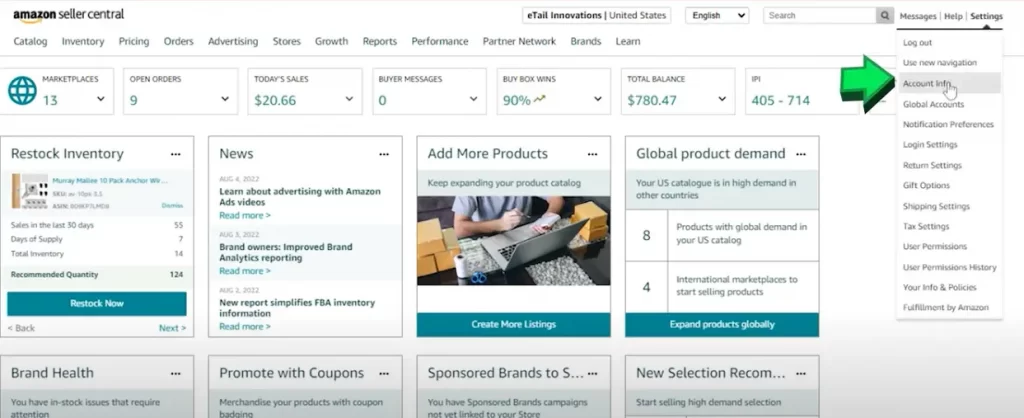
- This page displays your account information, including your current selling plan (Individual or Professional).
Step 3: Upgrade your selling plan:
- Look for the Your Services section on the Account Info page.
- Next to Sell on Amazon, you’ll see your current selling plan listed.
- Click on Manage next to your current selling plan.
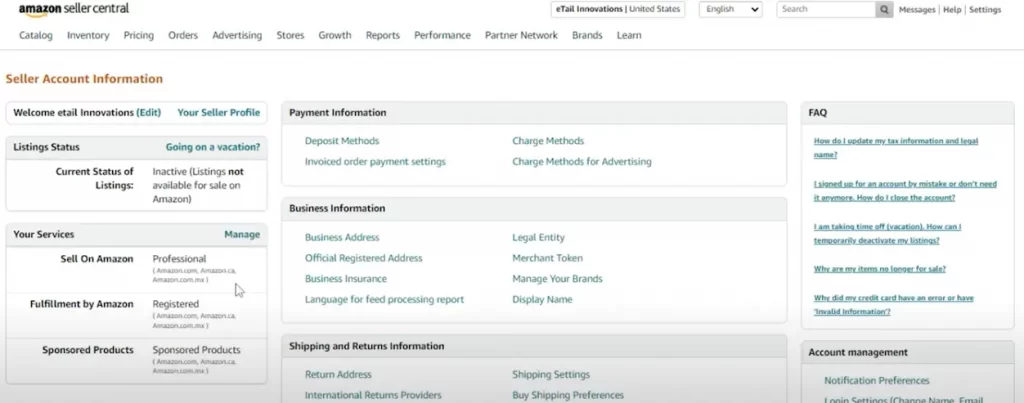
Step 4: Review and proceed with upgrade:
- You’ll be directed to the Manage Your Services page. Here, you’ll see the option to Upgrade to a Professional selling plan.
- Carefully review the terms and conditions associated with the Professional plan.

Step 5: Complete upgrade process
- You might be asked to provide additional information like your tax information or contact details.
- Enter the required information and follow any on-screen instructions to complete the upgrade process.
Step 6: Confirmation
- Once you complete the steps, you’ll receive a confirmation email from Amazon notifying you of the successful upgrade to a Professional selling plan.
- The upgrade usually happens immediately, and you should see the Professional designation next to your selling plan on your Seller Central account.
Amazon Individual vs Professional: FAQs
The main difference between Amazon individual vs professional lies in fees and features: Yes, you can easily switch from an Individual to a Professional seller account on Amazon. It’s a free process done through your Seller Central settings. Just be aware that the Professional plan has a monthly subscription fee, but offers advanced features like bulk listing and advertising that can boost your sales. The main benefit of an Amazon Individual seller account is its low upfront cost. There’s no monthly subscription fee, making it ideal for casual sellers or those just starting out. You only pay a per-item fee when you make a sale. However, it comes with limitations like basic listing tools and lack of advertising options. The better option depends on your sales volume and goals. For casual sellers with a low volume, an Individual account is cheaper (no monthly fee). But for serious sellers with a growing business, a Professional account is better. It offers advanced tools and advertising options and is cost-effective with higher sales volume (monthly fee vs. per-item fee).
Choose the Right Plan to Get Your Goals on Amazon
Between Amazon individual vs professional, the right plan depends on your business ambitions. The Individual plan is a budget-friendly option for casual sellers with a limited inventory. However, for those aiming to scale their business and unlock advanced features like bulk listing and advertising tools, the Professional plan offers a significant advantage.
If you still find it difficult to determine which Amazon account types are right for you, our advice is to choose the plan that best supports your current stage, as you can absolutely change the plan in the future.
To wrap things up, don’t miss out on the latest news and updates about the eCommerce industry by subscribing to our blog. And if you have any questions related to our articles or products, contact us for prompt and accurate responses!



